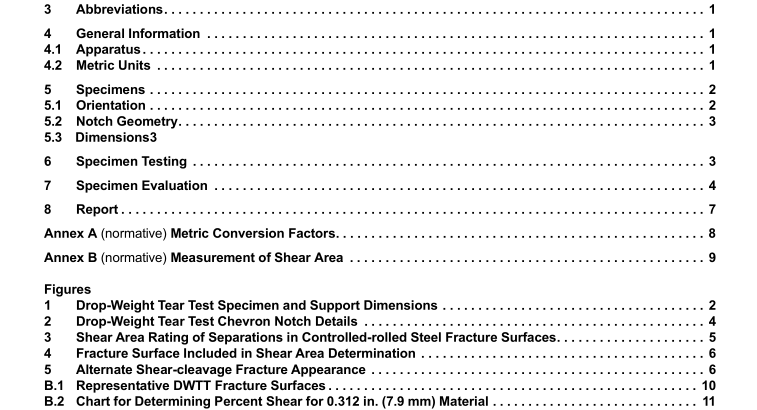API 5L3:2020 pdf free download.Drop-Weight Tear Tests on Line Pipe
These procedures describe a recommended method for conducting Drop-Weight Tear Tests to measure the fracture appearance or fracture ductility of the pipe as referenced in API Specification 5L, Specification for Line Pipe.
2 Normative References
The following referenced document is indispensable for the application of this document. For dated references, only the edition cited applies. For undated references, the latest edition of the referenced document (including any amendments) applies.
API Specification 5L, Specification for Line Pipe
3 Abbreviations
For the purposes of this document, the following abbreviations apply.
D/t diameter-to-thickness ratio
DWTT Drop-Weight Tear Test
t pipe wall thickness
T neglected regions for shear area evaluation
t s DWTT specimen thickness
4 General Information
4.1 Apparatus
4.1.1 The testing machine may be of any configuration that has sufficient energy to completely break the specimens
in one impact.
4.1.2 The velocity of the hammer at impact shall be in the range of 16 ft/sec to 30 ft/sec (5 m/sec to 9 m/sec).
4.1.3 The specimen shall be inserted in the testing machine so that the notch is lined up with the centerline of the hammer tip within 1 / 16 in. (1.59 mm). The notch should also be centered between the supports of the anvil.
4.1.4 The radius of the anvil supports for the specimen should not be larger than 5 / 8 in. (15.9 mm). Larger radii have been found to contribute to specimen jamming.
4.2 Metric Units Metric conversions of US customary units are shown in parenthesis in the test, figures, and tables. See Annex A for metric conversion factors. NOTE Drop-Weight Tear Testing pipe with upper shelf Charpy impact energies greater than 200 J (148 ft-lb) often results in invalid tests, making the test method ineffective.
5 Specimens
5.1 Orientation
5.1.1 The specimens shall be removed from pipe such that the length of the specimen is in the circumferential direction of the pipe.
5.1.2 The specimens shall be flattened unless the D/t is less than 40. If the D/t is less than 40, then the center 1 in. to 2 in. (25 mm to 51 mm) may be left unflattened. If buckling occurs, the test results are not valid and replacement tests shall be conducted. Flattening has been observed to decrease the percent shear of the fracture. In the case of a difference between flattened and nonflattened specimen results, or in referee testing, the results from nonflattened specimens shall govern.
5.1.3 The specimens may be removed from the pipe wall by sawing, shearing, or flame cutting with or without machining, provided the dimensions of the finished specimen are within the tolerances shown in Figure 1.
NOTE If the specimen is flame cut, it is usually difficult to press in the notch unless the heat-affected zone is removed by machining.
5.2 Notch GeometryThe pressed notch is the preferred notch. The chevron notch may be considered an alternative to the pressed notch, particularly for higher Charpy V-notch energy steels where invalid results are more likely to occur with pressed notch. The chevron notch can eliminate excess initiation energy associated with some higher toughness line-pipe steels, which frequently result in invalid specimens as defined in 7.1.
a) Pressed Notch. The pressed notch shall be pressed to the depth shown in Figure 1 with a sharp (no radius) tool steel chisel with an included angle of 45° ±2°.
Machined notches are prohibited. When many specimens are to be tested, it is helpful to use a jig which will guide the chisel and stop it at the proper depth.
b) Chevron Notch. The chevron notch shall be cut or machined to the 90° nominal configuration shown in Figure 2 with a width not to exceed 0.047 in. (1.2 mm). There is no notch radius requirement (i.e. the notch may be round or have a flat bottom).API 5L3 pdf download.API 5L3:2020 pdf free download
